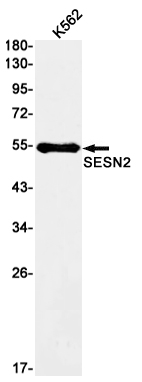-
Product Name
Anti-SESN2 Rabbit antibody
- Documents
-
Description
SESN2 Rabbit monoclonal antibody
-
Tested applications
WB, ICC/IF, FC, IP
-
Species reactivity
Human, Mouse, Rat
-
Alternative names
HI95; SES2; SEST2 antibody
-
Isotype
Rabbit IgG
-
Preparation
Antigen: Recombinant protein of human SESN2
-
Clonality
Monoclonal
-
Formulation
Supplied in 50nM Tris-Glycine(pH 7.4), 0.15M Nacl, 40%Glycerol, 0.01% sodium azide and 0.05% BSA.
-
Storage instructions
Store at 4°C short term. Aliquot and store at -20°C long term. Avoid freeze / thaw cycle.
-
Applications
WB: 1/1000
ICC/IF: 1/20
FC: 1/20
IP: 1/20
-
Validations

Western blot detection of SESN2 in K562 cell lysates using SESN2 Rabbit mAb(1:1000 diluted).Predicted band size:55kDa.Observed band size:55kDa.
-
Background
Swiss-Prot Acc.P58004.Functions as an intracellular leucine sensor that negatively regulates the TORC1 signaling pathway through the GATOR complex. In absence of leucine, binds the GATOR subcomplex GATOR2 and prevents TORC1 signaling (PubMed:18692468, PubMed:25263562, PubMed:25457612, PubMed:26449471, PubMed:26612684, PubMed:26586190). Binding of leucine to SESN2 disrupts its interaction with GATOR2 thereby activating the TORC1 signaling pathway (PubMed:26449471, PubMed:26586190). This stress-inducible metabolic regulator also plays a role in protection against oxidative and genotoxic stresses. May negatively regulate protein translation in response to endoplasmic reticulum stress, via TORC1 (PubMed:24947615). May positively regulate the transcription by NFE2L2 of genes involved in the response to oxidative stress by facilitating the SQSTM1-mediated autophagic degradation of KEAP1 (PubMed:23274085). May also mediate TP53 inhibition of TORC1 signaling upon genotoxic stress (PubMed:18692468). Has an alkylhydroperoxide reductase activity born by the N-terminal domain of the protein (PubMed:26612684). Was originally reported to contribute to oxidative stress resistance by reducing PRDX1 (PubMed:15105503). However, this could not be confirmed (PubMed:19113821).
Related Products / Services
Please note: All products are "FOR RESEARCH USE ONLY AND ARE NOT INTENDED FOR DIAGNOSTIC OR THERAPEUTIC USE"
